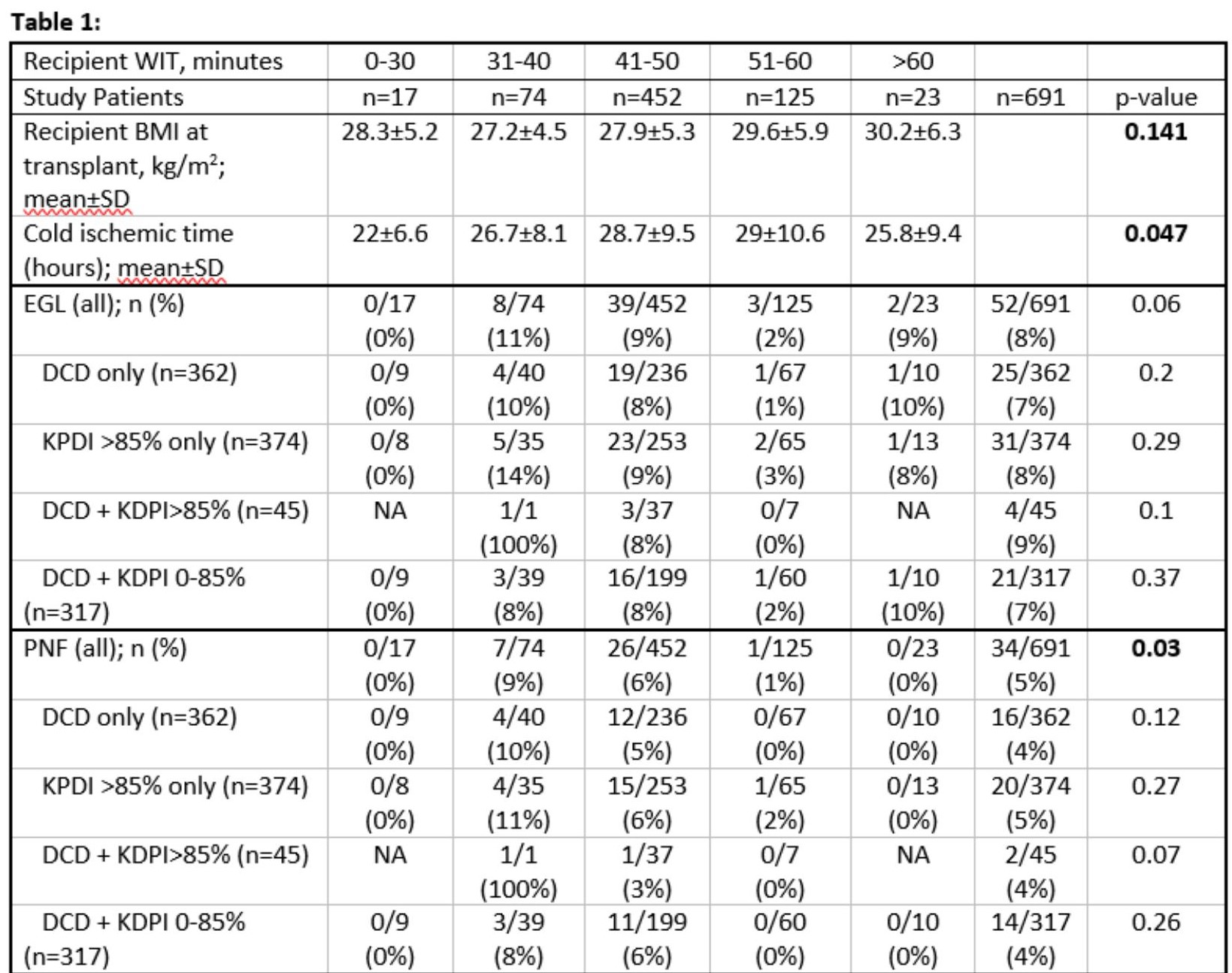Impact of Recipient Warm Ischemic Time on Outcomes Associated with High KDPI and DCD Donor Kidneys: Cold Ischemic Time Remains Paramount
Department of Surgery, Atrium Health Wake Forest Baptist, Winston Salem, NC
Meeting: 2022 American Transplant Congress
Abstract number: 295
Keywords: Donors, marginal, Graft survival, High-risk, Warm ischemia
Topic: Clinical Science » Kidney » 41 - Kidney Technical
Session Information
Session Time: 5:30pm-7:00pm
 Presentation Time: 6:40pm-6:50pm
Presentation Time: 6:40pm-6:50pm
Location: Hynes Room 312
*Purpose: Previously we demonstrated that cold ischemic time (CIT) beyond 24 hours was an important risk predictor of early graft loss (EGL) and primary non-function (PNF) for donation after cardiac death (DCD) or Kidney Donor Profile Index (KDPI) >85% kidney transplants. CIT >24 hours was associated with increased risks of EGL by more than 2-fold and PNF by more than 3-fold for either DCD or KDPI >85% transplants. We sought to understand the contribution of recipient warm ischemic time (RWIT) on these outcomes.
*Methods: We performed a single center retrospective review of single adult DCD and KDPI >85% deceased donor kidney transplant (DDKT) alone recipients from 2002-2018 (n=691) evaluating rates of EGL (defined as graft failure within first 90 days) or PNF according to RWIT. The effect of CIT compared with RWIT was analyzed according to odds ratios (OR) including 95% confidence intervals (CI). There were 362 DCD, 374 KDPI >85%, 45 both DCD with KDPI >85%, and 317 DCD with KDPI 0-85% DDKTs.
*Results: EGL and PNF occurred in 25 (7%) and 16 (4%) of DCD, 31 (8%) and 20 (5%) of KDPI>85%, and 4 (9%) and 2 (4%) of DCD & KDPI>85% transplants, respectively. There were no cases of EGL or PNF if RWIT was less than 30 minutes. Rates of EGL and PNF according to RWIT are shown in Table 1. Recipient BMI correlated with prolonged RWIT (Table 1). CIT was strongly predictive of EGL, but RWIT was not a significant risk predictor of EGL after accounting for CIT (CIT: OR=1.04 per hour, 95% CI=1.02-1.07; RWIT: OR=0.98 per minute, 95% CI=0.93-1.02). These findings were similar when comparing DCD and KDPI subgroups.
*Conclusions: There were no cases of EGL and PNF when the RWIT was <30 minutes, but CIT remains the most important factor in predicting EGL and PNF for DCD and KDPI >85% kidney transplants. When using DCD and KDPI >85% kidneys, it is important to consider recipient factors such as BMI, which might lengthen RWIT. Still, attention to allocation policies that reduce CIT are critical to optimizing outcomes with these donor organs.
To cite this abstract in AMA style:
Jacobs ML, Stratta R, Garner M, Sharda B, Farney A, Orlando G, Reeves-Daniel A, Jay C. Impact of Recipient Warm Ischemic Time on Outcomes Associated with High KDPI and DCD Donor Kidneys: Cold Ischemic Time Remains Paramount [abstract]. Am J Transplant. 2022; 22 (suppl 3). https://atcmeetingabstracts.com/abstract/impact-of-recipient-warm-ischemic-time-on-outcomes-associated-with-high-kdpi-and-dcd-donor-kidneys-cold-ischemic-time-remains-paramount/. Accessed December 28, 2025.« Back to 2022 American Transplant Congress

